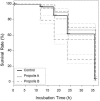Inside Honeybee Hives: Impact of Natural Propolis on the Ectoparasitic Mite Varroa destructor and Viruses
- PMID: 28178181
- PMCID: PMC5371943
- DOI: 10.3390/insects8010015
Inside Honeybee Hives: Impact of Natural Propolis on the Ectoparasitic Mite Varroa destructor and Viruses
Abstract
Social immunity is a key factor for honeybee health, including behavioral defense strategies such as the collective use of antimicrobial plant resins (propolis). While laboratory data repeatedly show significant propolis effects, field data are scarce, especially at the colony level. Here, we investigated whether propolis, as naturally deposited in the nests, can protect honeybees against ectoparasitic mites Varroa destructor and associated viruses, which are currently considered the most serious biological threat to European honeybee subspecies, Apis mellifera, globally. Propolis intake of 10 field colonies was manipulated by either reducing or adding freshly collected propolis. Mite infestations, titers of deformed wing virus (DWV) and sacbrood virus (SBV), resin intake, as well as colony strength were recorded monthly from July to September 2013. We additionally examined the effect of raw propolis volatiles on mite survival in laboratory assays. Our results showed no significant effects of adding or removing propolis on mite survival and infestation levels. However, in relation to V. destructor, DWV titers increased significantly less in colonies with added propolis than in propolis-removed colonies, whereas SBV titers were similar. Colonies with added propolis were also significantly stronger than propolis-removed colonies. These findings indicate that propolis may interfere with the dynamics of V. destructor-transmitted viruses, thereby further emphasizing the importance of propolis for honeybee health.
Keywords: Apis mellifera; deformed wing virus; plant-insect interactions; resin; sacbrood virus; social immunity.
Conflict of interest statement
The authors declare no conflict of interest.
Figures




Similar articles
-
On the front line: quantitative virus dynamics in honeybee (Apis mellifera L.) colonies along a new expansion front of the parasite Varroa destructor.PLoS Pathog. 2014 Aug 21;10(8):e1004323. doi: 10.1371/journal.ppat.1004323. eCollection 2014 Aug. PLoS Pathog. 2014. PMID: 25144447 Free PMC article.
-
Occurrence of multiple honeybee viruses in the ectoparasitic mites Varroa spp. in Apis cerana colonies.J Invertebr Pathol. 2019 Sep;166:107225. doi: 10.1016/j.jip.2019.107225. Epub 2019 Jul 29. J Invertebr Pathol. 2019. PMID: 31369733
-
Acaricide treatment affects viral dynamics in Varroa destructor-infested honey bee colonies via both host physiology and mite control.Appl Environ Microbiol. 2012 Jan;78(1):227-35. doi: 10.1128/AEM.06094-11. Epub 2011 Oct 21. Appl Environ Microbiol. 2012. PMID: 22020517 Free PMC article.
-
Virus Infections of Honeybees Apis Mellifera.Ital J Food Saf. 2015 Sep 25;4(3):5364. doi: 10.4081/ijfs.2015.5364. eCollection 2015 Jun 30. Ital J Food Saf. 2015. PMID: 27800411 Free PMC article. Review.
-
[Research progress of the interaction between Apis mellifera and Varroa destructor mediated by pheromones].Ying Yong Sheng Tai Xue Bao. 2017 Jun 18;28(6):2055-2062. doi: 10.13287/j.1001-9332.201706.012. Ying Yong Sheng Tai Xue Bao. 2017. PMID: 29745171 Review. Chinese.
Cited by
-
Propolis Contra Pharmacological Interventions in Bees.Molecules. 2022 Aug 1;27(15):4914. doi: 10.3390/molecules27154914. Molecules. 2022. PMID: 35956862 Free PMC article. Review.
-
Composition and functional properties of propolis (bee glue): A review.Saudi J Biol Sci. 2019 Nov;26(7):1695-1703. doi: 10.1016/j.sjbs.2018.08.013. Epub 2018 Aug 17. Saudi J Biol Sci. 2019. PMID: 31762646 Free PMC article. Review.
-
Propolis Consumption Reduces Nosema ceranae Infection of European Honey Bees (Apis mellifera).Insects. 2020 Feb 15;11(2):124. doi: 10.3390/insects11020124. Insects. 2020. PMID: 32075232 Free PMC article.
-
Propolis Extract and Chitosan Improve Health of Nosema ceranae Infected Giant Honey Bees, Apis dorsata Fabricius, 1793.Pathogens. 2021 Jun 22;10(7):785. doi: 10.3390/pathogens10070785. Pathogens. 2021. PMID: 34206455 Free PMC article.
-
The Strong Anti-Kinetoplastid Properties of Bee Propolis: Composition and Identification of the Active Agents and Their Biochemical Targets.Molecules. 2020 Nov 5;25(21):5155. doi: 10.3390/molecules25215155. Molecules. 2020. PMID: 33167520 Free PMC article. Review.
References
-
- Ellis J.D., Evans J.D., Pettis J. Colony losses, managed colony population decline, and Colony Collapse Disorder in the United States. J. Apic. Res. 2010;49:134–136. doi: 10.3896/IBRA.1.49.1.30. - DOI
-
- Potts S.G., Roberts S.P.M., Dean R., Marris G., Brown M.A., Jones R., Neumann P., Settele J. Declines of managed honey bees and beekeepers in Europe. J. Apic. Res. 2010;49:15–22. doi: 10.3896/IBRA.1.49.1.02. - DOI
-
- Neumann P., Carreck N.L. Honey bee colony losses. J. Apic. Res. 2010;49:1–6. doi: 10.3896/IBRA.1.49.1.01. - DOI
-
- VanEngelsdorp D., Hayes J., Jr., Underwood R.M., Caron D., Pettis J. A survey of managed honey bee colony losses in the USA, fall 2009 to winter 2010. J. Apic. Res. 2011;50:1–10. doi: 10.3896/IBRA.1.50.1.01. - DOI
-
- Kosior A., Celary W., Olejniczak P., Fijal J., Krol W., Solarz W., Plonka P. The decline of the bumble bees and cuckoo bees (Hymenoptera: Apidae: Bombini) of Western and Central Europe. Oryx. 2007;41:79–88. doi: 10.1017/S0030605307001597. - DOI
LinkOut - more resources
Full Text Sources
Other Literature Sources

